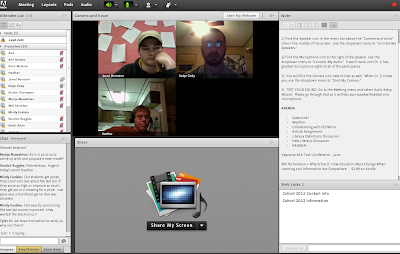This marks the beginning of a series of UNI Connect-A-Tech Webinars where we will be talking with Instructional Technology alumni who are working as professionals in their fields of choice.
You will have the opportunity to interact with them through a video conferencing system. Read the information below to see how you can be involved through a video conference, on your phone, or come to our classroom at UNI (Schindler Education Center 405).
If you have questions: Contact Nikki Lyons or use the comments below.
=============================================================
You will have the opportunity to interact with them through a video conferencing system. Read the information below to see how you can be involved through a video conference, on your phone, or come to our classroom at UNI (Schindler Education Center 405).
If you have questions: Contact Nikki Lyons or use the comments below.
=============================================================
UNI Connect-A-Tech Webinar Series:
Instructional Designers
|
Wondering what it takes to be an Instructional Designer?
Here is your opportunity to meet with successful instructional designers and ask them the questions you want to know about the profession.
You can connect with UNI Instructional Technology alumni who work in fields that you plan to pursue after graduation. Through talking with the professionals, you can develop an understanding of the skills and perspectives necessary for pursuing your career. This webinar will feature:
You can connect with UNI Instructional Technology alumni who work in fields that you plan to pursue after graduation. Through talking with the professionals, you can develop an understanding of the skills and perspectives necessary for pursuing your career. This webinar will feature:
- Isandra Martinez-Marrero, Lead Instructional Designer, Division of Continuing Education, University of Iowa
When: Thursday, April 17 from noon - 1:00 (Central Daylight Time)
Where: You will be able to experience this online, on the phone or in a
UNI classroom (SEC 403)
Participant ID: Shown after joining the meeting
|
Follow Us on Twitter: #UNIConTech







